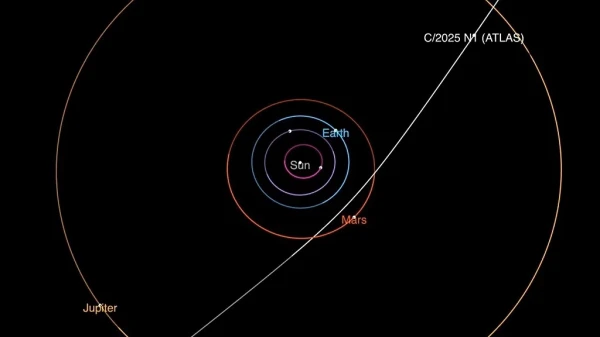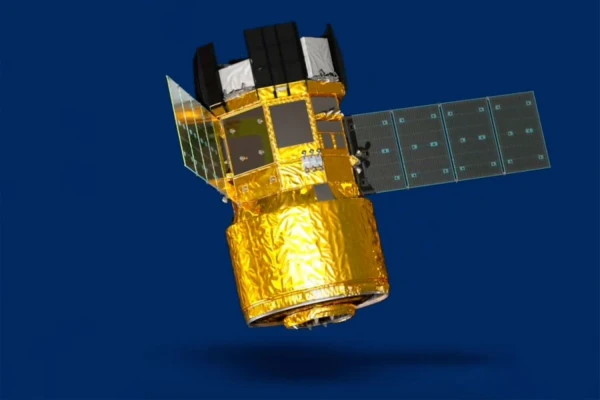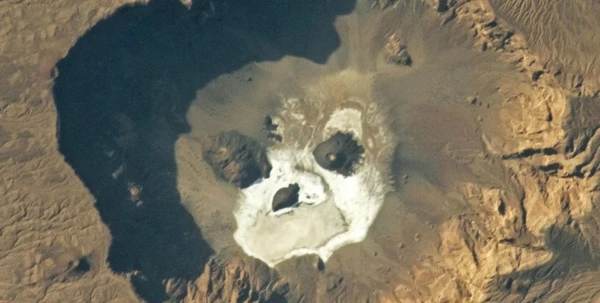
This diagram, provided by NASA/JPL-Caltech, shows the trajectory of the interstellar comet 3I/ATLAS as it passes through the Solar System.
On July 1, 2025, astronomers discovered a faint and rapidly moving object. Officially named 3I/ATLAS, it was recognized as the third confirmed interstellar comet. However, some scientists do not rule out the possibility that the discovered object is an alien spacecraft.
On July 1, 2025, astronomers using the ATLAS (Asteroid Terrestrial-impact Last Alert System) survey telescope located in Rio Hurtado, Chile, detected a faint rapidly moving object.
Officially named 3I/ATLAS (C/2025 N1), it became the third confirmed interstellar object in history after ʻOumuamua in 2017 and 2I/Borisov in 2019.
What exactly is 3I/ATLAS? Where is it headed, and could this strange cosmic visitor be more than just a comet?
Its name reflects its origin: "3" - the third discovered cosmic object, "I" - interstellar, "ATLAS" - the network of telescopes that detected it.
What makes this interstellar comet unusual is the presumed location of its origin. The speed and trajectory of the object indicate that it is not gravitationally bound to the Sun, meaning it must have originated in another star system and accidentally "wandered" into ours.
At what speed is the interstellar comet moving and where is it headed?
According to astronomers, 3I/ATLAS is racing through space at a speed of over 200,000 km/h (about 61 km per second), and its speed increases as it approaches the Sun.
This Tuesday, October 29, 2025, 3I/ATLAS will pass perihelion (the closest point to the Sun in its orbit), coming within a minimum distance of about 203.5 million km (1.36 AU) from the Sun. Since the interstellar comet will be near the star and lost in its rays, it will not be observable in October.
The object is moving on a hyperbolic orbit, meaning it is too fast to be captured by the Sun's gravity.
"3I/ATLAS will rush through the Solar System - between the orbits of Mars and Earth, and then fly past the Sun," said Con Stoitsis, director of the comet and meteor department at the Astronomical Society of Victoria, to The Guardian. "This interstellar comet is on what is called a hyperbolic orbit. That is, it is not gravitationally bound to the Sun. It is moving too fast, so it will easily fly out of the Solar System."
According to NASA, the closest distance at which 3I/ATLAS will approach Earth is about 270 million kilometers.
Is 3I/ATLAS more than just a natural object?
When the ATLAS telescope network discovered this interstellar comet, social media and the media began discussing that the found object is an alien spacecraft. One of the main proponents of this theory is Harvard astrophysicist Professor Avi Loeb. Why has the hypothesis about aliens suddenly gained so many supporters? And what does 3I/ATLAS say about our capabilities for exploring space?
For most astronomers, 3I/ATLAS is an exciting but natural phenomenon. Nevertheless, Professor Avi Loeb insists on the need for a more thorough investigation of the object.
As part of the "Galileo" project, which studies potential evidence of extraterrestrial civilizations, Loeb poses provocative questions about the origin of 3I/ATLAS. In a series of scientific essays published on Medium, he argues that scientists should still consider the possibility that the object may be alien technology - an artificial probe or artifact from another civilization.
In one of the essays titled "Does 3I/ATLAS Generate Its Own Light?" Loeb questions whether the brightness of the object is a result of self-luminescence rather than reflected sunlight. This property is not found in any known comets.
"The hypothesis is that the recent interstellar guest of our Solar System, 3I/ATLAS1-10, is a technological artifact and, moreover, possesses active intelligence. If so, two scenarios are possible: first, its intentions are entirely benevolent, and second, they are malevolent," he writes in an article titled "Is the Interstellar Object 3I/ATLAS Alien Technology?"
"If the hypothesis turns out to be true, the consequences for humanity could potentially be dire and may require protective measures," he warned.
NASA has firmly rejected Loeb's viewpoint. "The object looks like a comet and does what a comet does. It strongly resembles known comets in almost every way," said Tom Statler, NASA's leading scientist for small bodies in the Solar System, in an interview with The Guardian.
Let us maintain childlike curiosity and seek evidence rather than pretend to be adults who already know the answers.
Subsequently, Loeb acknowledged in a blog that "the simplest hypothesis is that 3I/ATLAS is a comet," clarifying that his goal was to challenge existing assumptions rather than assert.
The size and physical properties of the object are still being studied, but NASA claims that the interstellar comet should become visible again to ground-based telescopes in early December when it emerges from behind the Sun.













Leave a comment